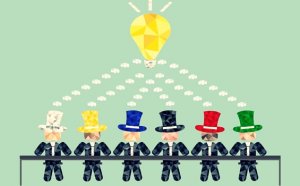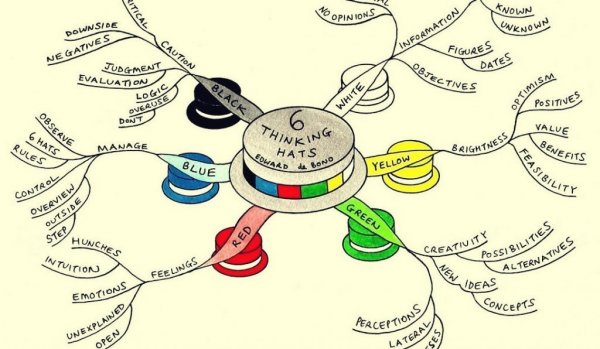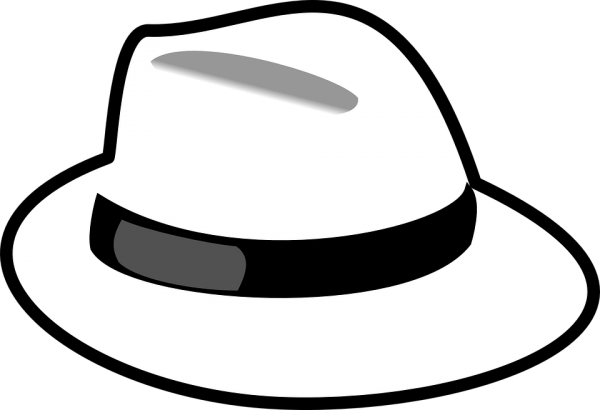Edward de Bono's Six Thinking Hats Technique


Written and verified by the psychologist Gema Sánchez Cuevas
A lot of you have probably heard of it, and if so, it’s probably helped you solve problems more creatively. The six thinking hats technique, developed by Edward de Bono, is a communication and reasoning tool. You use it to see from new perspectives by applying lateral thinking.
Edward de Bono is 84 years old now, but he’s still active. This Maltese psychologist, professor at Oxford University, has given us a priceless legacy in the world of creativity. His legacy has particularly impacted management and leadership.
“Thinking is the ultimate human resource. Yet we can never be satisfied with our most important skill. No matter how good we become, we should always want to be better.”
-Edward de Bono-
The six thinking hats technique is a classic dynamic for encouraging communication in businesses, but it’s also common as an exercise in universities and elementary school classrooms. There, it’s used to teach children how to think better and make decisions as a group.
One thing de Bono emphasizes (also in his other books, like Practical Thinking, Water Logic, and The Use of Lateral Thinking) is that we should all learn to think better. And as part of that “we should,” he also points out an interesting fact. It’s the fact that we actually can learn to think.
Opening yourself up to other viewpoints, learning to be more flexible, reflective, and original in your patterns of reasoning won’t just help you make better decisions. It will also improve the quality of your relationships and make you more productive.

The Six Thinking Hats technique
Edward de Bono’s six thinking hats technique always follows the same pattern, the same strategy. But as simple as it might seem at first, is has an incredibly positive impact on our brains. That’s because it’s essentially “training” to learn to think better.
De Bono says that something as simple as putting a hat on your head is often a deliberate act. Your thoughts should follow that rule too: “be deliberate and very careful.” Thinking well so you can live better is a rule worth following. The idea is to use different “hats” to learn a varied, agile, and creative style of thought.
The technique represents the six directions of thought as six imaginary hats. When a problem arises or you try to make a decision, each hat will be a premise, a vision, a specific framework. Once you’ve put them all on, proactively, you’ll feel more ready to make a decision.
Now we’ll take a look at what each hat teaches us.
The white hat

This hat will show you how to see things from an objective, neutral, and unbiased point of view. The style of thought you’ll apply will be based on analyzing the facts and comparing the information at hand, without making any value judgments.
- The white hat looks for concrete facts.
- It does not make interpretations or give opinions.
The black hat
The black hat represents the logical negative side and shows you why certain things might go wrong, not work, or not happen the way you thought. The technique of six thinking hats will also help you be critical and see the negative side of things. This will help you be more realistic.
- Sometimes you have to be aware of difficult or complex facts, dead-ends that you have to accept in order to find better ways out.
- The black hat type of thought feeds on your past experiences. The ones that remind you of yesterday’s mistakes, the ones that tell you it’s better to try new things and not fall into the same old traps.
“The important thing with a bike–or creative thinking–is to move. The brakes–or negative thinking–are just a safety mechanism.”
-Edward de Bono-
The green hat
- The green hat demands originality, creativity, crossing boundaries, and making the impossible possible.
- This is that hat that encompasses lateral thinking. It invites you to be more provocative and less conservative.
- This kind of thought reminds you that it’s not good to be satisfied too quickly. You have to look for and maybe create other roads to take, other alternatives, other possibilities…
The red hat

- The red hat is passionate, emotional, and feels life from the heart.
- While the white hat helps you use a more neutral, careful, and objective logic, the red hat will throw you into the unknown so you can embrace a world of lively, free subjectivity.
- So when you put on the red hat, you’ll have the chance to say out loud what lights your fire, what makes you feel uneasy. It’s time for your intuition to say something about the information you have. And it will also help you understand other people’s emotions and needs.
The yellow hat
While the black hat gives you the logical-negative focus that’s useful for being more realistic in your daily life, the yellow hat will show you how to apply a logical-positive focus.
- The yellow hat will open your eyes to possibilities where other people see closed doors.
- It will help you see things constructively and optimistically.
- But this positivity and openness is always ruled by logic. If you don’t keep keep the logical lens and let your irrational passions take over, you’ll be using the red hat, not the yellow one.
The blue hat

The color blue is all-encompassing. It’s always there and it controls everything. It also transmits calm, balance, and self-control. So when it comes to the technique of six thinking hats, this is the one that controls the whole process. You use it two times in this technique: at the beginning and at the end.
- At first, you use it to decide which hats you’re going to put on and what order to go in. Then you use it at the end to make a decision.
- This means that the blue hat represents structured thought. It’s the center and your guide, pointing out alternatives, suggesting new strategies, and maintaining control at every point along the way. It will keep you from getting distracted or stuck.
Edward de Bono’s six thinking hats technique is a helpful strategy for better decision-making. You can use it to work through different thinking styles in order to evaluate the problems and facts from all possible perspectives. The answers you’ll come to at the end won’t just be more accurate, they’ll also be much more creative and original.
A lot of you have probably heard of it, and if so, it’s probably helped you solve problems more creatively. The six thinking hats technique, developed by Edward de Bono, is a communication and reasoning tool. You use it to see from new perspectives by applying lateral thinking.
Edward de Bono is 84 years old now, but he’s still active. This Maltese psychologist, professor at Oxford University, has given us a priceless legacy in the world of creativity. His legacy has particularly impacted management and leadership.
“Thinking is the ultimate human resource. Yet we can never be satisfied with our most important skill. No matter how good we become, we should always want to be better.”
-Edward de Bono-
The six thinking hats technique is a classic dynamic for encouraging communication in businesses, but it’s also common as an exercise in universities and elementary school classrooms. There, it’s used to teach children how to think better and make decisions as a group.
One thing de Bono emphasizes (also in his other books, like Practical Thinking, Water Logic, and The Use of Lateral Thinking) is that we should all learn to think better. And as part of that “we should,” he also points out an interesting fact. It’s the fact that we actually can learn to think.
Opening yourself up to other viewpoints, learning to be more flexible, reflective, and original in your patterns of reasoning won’t just help you make better decisions. It will also improve the quality of your relationships and make you more productive.

The Six Thinking Hats technique
Edward de Bono’s six thinking hats technique always follows the same pattern, the same strategy. But as simple as it might seem at first, is has an incredibly positive impact on our brains. That’s because it’s essentially “training” to learn to think better.
De Bono says that something as simple as putting a hat on your head is often a deliberate act. Your thoughts should follow that rule too: “be deliberate and very careful.” Thinking well so you can live better is a rule worth following. The idea is to use different “hats” to learn a varied, agile, and creative style of thought.
The technique represents the six directions of thought as six imaginary hats. When a problem arises or you try to make a decision, each hat will be a premise, a vision, a specific framework. Once you’ve put them all on, proactively, you’ll feel more ready to make a decision.
Now we’ll take a look at what each hat teaches us.
The white hat

This hat will show you how to see things from an objective, neutral, and unbiased point of view. The style of thought you’ll apply will be based on analyzing the facts and comparing the information at hand, without making any value judgments.
- The white hat looks for concrete facts.
- It does not make interpretations or give opinions.
The black hat
The black hat represents the logical negative side and shows you why certain things might go wrong, not work, or not happen the way you thought. The technique of six thinking hats will also help you be critical and see the negative side of things. This will help you be more realistic.
- Sometimes you have to be aware of difficult or complex facts, dead-ends that you have to accept in order to find better ways out.
- The black hat type of thought feeds on your past experiences. The ones that remind you of yesterday’s mistakes, the ones that tell you it’s better to try new things and not fall into the same old traps.
“The important thing with a bike–or creative thinking–is to move. The brakes–or negative thinking–are just a safety mechanism.”
-Edward de Bono-
The green hat
- The green hat demands originality, creativity, crossing boundaries, and making the impossible possible.
- This is that hat that encompasses lateral thinking. It invites you to be more provocative and less conservative.
- This kind of thought reminds you that it’s not good to be satisfied too quickly. You have to look for and maybe create other roads to take, other alternatives, other possibilities…
The red hat

- The red hat is passionate, emotional, and feels life from the heart.
- While the white hat helps you use a more neutral, careful, and objective logic, the red hat will throw you into the unknown so you can embrace a world of lively, free subjectivity.
- So when you put on the red hat, you’ll have the chance to say out loud what lights your fire, what makes you feel uneasy. It’s time for your intuition to say something about the information you have. And it will also help you understand other people’s emotions and needs.
The yellow hat
While the black hat gives you the logical-negative focus that’s useful for being more realistic in your daily life, the yellow hat will show you how to apply a logical-positive focus.
- The yellow hat will open your eyes to possibilities where other people see closed doors.
- It will help you see things constructively and optimistically.
- But this positivity and openness is always ruled by logic. If you don’t keep keep the logical lens and let your irrational passions take over, you’ll be using the red hat, not the yellow one.
The blue hat

The color blue is all-encompassing. It’s always there and it controls everything. It also transmits calm, balance, and self-control. So when it comes to the technique of six thinking hats, this is the one that controls the whole process. You use it two times in this technique: at the beginning and at the end.
- At first, you use it to decide which hats you’re going to put on and what order to go in. Then you use it at the end to make a decision.
- This means that the blue hat represents structured thought. It’s the center and your guide, pointing out alternatives, suggesting new strategies, and maintaining control at every point along the way. It will keep you from getting distracted or stuck.
Edward de Bono’s six thinking hats technique is a helpful strategy for better decision-making. You can use it to work through different thinking styles in order to evaluate the problems and facts from all possible perspectives. The answers you’ll come to at the end won’t just be more accurate, they’ll also be much more creative and original.
This text is provided for informational purposes only and does not replace consultation with a professional. If in doubt, consult your specialist.







